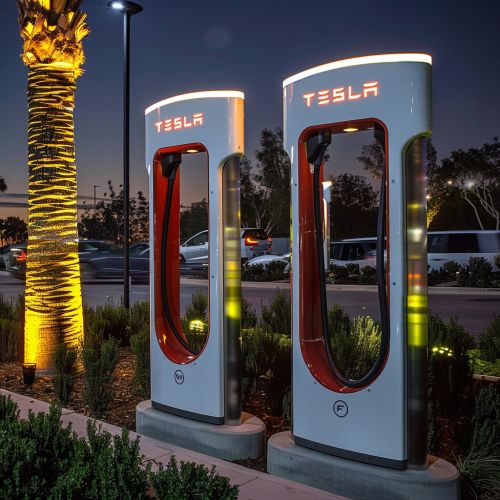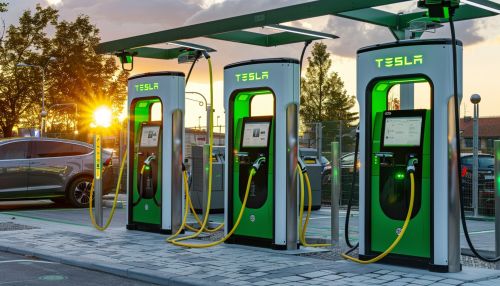Fast Charging
Introduction
Fast charging is a technology that allows the rapid replenishment of the energy stored in rechargeable batteries, significantly reducing the time it takes to recharge a device compared to traditional charging methods. This technology has become increasingly important as the demand for portable electronic devices such as smartphones, tablets, and electric vehicles (EVs) has grown.


Principles of Fast Charging
The principle of fast charging is based on increasing the amount of electric current that is delivered to a battery. This is achieved by increasing the power output of the charging source, which is typically measured in watts (W). The power output is a product of the voltage (V) and current (I), as described by the formula P=VI.
Batteries have a maximum charging rate, or 'C-rate', which is the rate at which a battery can be charged without causing damage or reducing its lifespan. The C-rate is typically expressed as a multiple of the battery's capacity. For example, a battery with a capacity of 2000mAh that is charged at a rate of 2000mA (or 2A) is said to be charging at a 1C rate.
Fast charging technologies typically operate at a C-rate that is higher than 1C, allowing the battery to be charged more quickly. However, charging at a high C-rate can generate heat and potentially damage the battery if not properly managed.
Types of Fast Charging
There are several types of fast charging technologies that are currently in use, each with its own set of advantages and disadvantages.
Direct Current (DC) Fast Charging
Direct Current (DC) fast charging, also known as Level 3 charging, is the fastest method of charging currently available. It bypasses the onboard charger of an electric vehicle and provides DC power directly to the battery. This allows for a much higher power output than AC charging, with some DC fast chargers capable of delivering up to 350kW. However, DC fast charging requires specialized charging equipment and is more expensive to install and operate than AC charging.
Alternating Current (AC) Fast Charging
Alternating Current (AC) fast charging, also known as Level 2 charging, is a more common method of fast charging. It uses the onboard charger of the electric vehicle to convert AC power from the charging station to DC power for the battery. AC fast charging is slower than DC fast charging, with a typical power output of 3.3 to 19.2kW. However, it is less expensive to install and operate and is more widely available.
High-Frequency Pulse Charging
High-frequency pulse charging is a method of fast charging that uses a high-frequency pulse of current to charge the battery. This method can reduce the charging time and improve the lifespan of the battery by reducing the heat generated during charging. However, it requires specialized charging equipment and is not widely used.
Fast Charging Standards
There are several fast charging standards that have been developed by various organizations and companies. These standards define the technical specifications for fast charging, including the power output, voltage, and current, as well as the design of the charging connector and the communication protocol between the charger and the device.
CHAdeMO
CHAdeMO is a fast charging standard that was developed by a consortium of Japanese companies, including Toyota, Nissan, and Mitsubishi. It supports DC fast charging with a power output of up to 62.5kW, and is widely used in Japan and other parts of Asia.
Combined Charging System (CCS)
The Combined Charging System (CCS) is a fast charging standard that was developed by a consortium of European and American car manufacturers, including BMW, Ford, and Volkswagen. It supports both AC and DC fast charging, with a maximum power output of 350kW for DC fast charging.
Tesla Supercharger
The Tesla Supercharger is a proprietary fast charging standard developed by Tesla. It supports DC fast charging with a power output of up to 250kW. The Supercharger network is exclusive to Tesla vehicles and is not compatible with other fast charging standards.
Impact of Fast Charging
Fast charging has a significant impact on the usability and convenience of electric vehicles and other portable electronic devices. By reducing the time it takes to recharge a device, fast charging makes it more practical to use these devices in a wider range of situations.
However, fast charging also has some potential drawbacks. The increased power output can generate heat and potentially damage the battery if not properly managed. This can reduce the lifespan of the battery and increase the risk of battery failure.
In addition, the infrastructure required for fast charging, particularly DC fast charging, is more expensive to install and operate than traditional charging infrastructure. This can increase the cost of owning and operating an electric vehicle or other device that uses fast charging.
Future of Fast Charging
The future of fast charging is likely to involve further increases in charging speed, as well as improvements in the efficiency and safety of fast charging technologies. New technologies, such as gallium nitride (GaN) chargers, are being developed that could potentially offer even faster charging speeds and higher efficiency than current fast charging technologies.
In addition, there is ongoing research into new battery technologies, such as solid-state batteries, that could potentially support even faster charging speeds and have a longer lifespan than current battery technologies.
